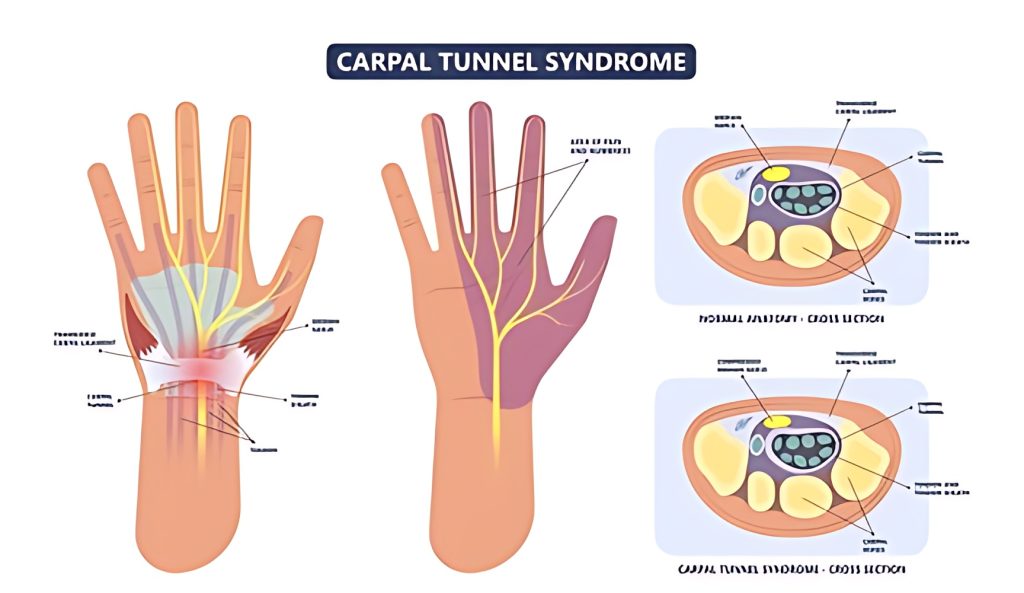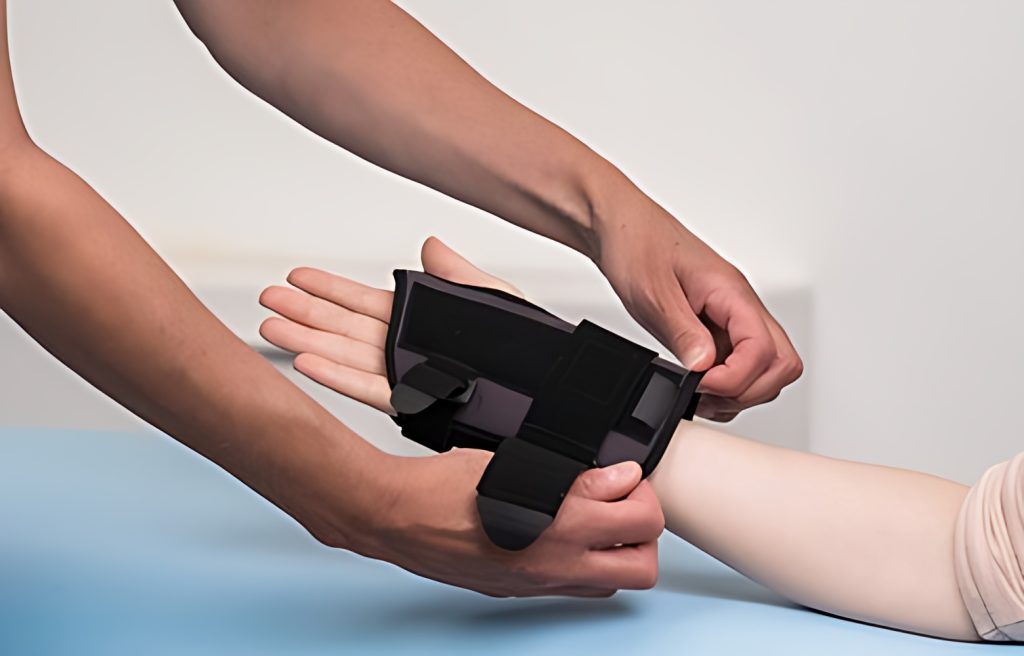Carpal Tunnel Syndrome
Carpal tunnel syndrome occurs when the median nerve in the wrist is compressed, leading to sensations of tingling, numbness, weakness, and pain in the hand and fingers. Treatment options range from physical therapy, exercises, and icing to wearing splints, taking pain medication, and receiving cortisone injections. In severe cases, surgery might be necessary.

Carpal Tunnel Symptoms
Symptoms of carpal tunnel syndrome include:
- Burning, tingling, or itchy numbness in the palm, thumb, index, and middle fingers
- Hand weakness and difficulty gripping objects
- Electric shock-like sensations radiating into the fingers
- Tingling sensations extending up the arm
What Leads to Carpal Tunnel Syndrome?
Carpal tunnel syndrome occurs when there is increased pressure on the median nerve in your wrist, causing pain. Inflammation often results in swelling, with the primary cause being an underlying medical condition that triggers wrist swelling and, at times, obstructed blood flow. Common medical conditions associated with carpal tunnel syndrome include:
- Diabetes
- Thyroid disorders
- Fluid retention during pregnancy or menopause
- High blood pressure
- Autoimmune disorders such as rheumatoid arthritis
- Wrist fractures or trauma
Carpal tunnel syndrome can worsen with repeated overextension of the wrist. Continuously extending your wrist can lead to swelling and compression of the median nerve in the carpal tunnel:
- Wrist positioning when using a keyboard or mouse
- Prolonged exposure to vibrations from hand tools or power tools
- Repetitive movements that overextend the wrist, such as playing the piano or typing for long periods of time.
How is Carpal Tunnel Syndrome Diagnosed?

To diagnose carpal tunnel syndrome, your doctor will first discuss your symptoms, medical history, and conduct a physical examination. Various tests may be performed, including:
- Tinel’s sign: In this test, the doctor taps the median nerve at the wrist to check for tingling sensations in the fingers.
- Wrist flexion test (or Phalen test): During this test, the patient places their elbows on a table, allowing the wrist to fall forward freely. Those with carpal tunnel syndrome will experience numbness and tingling in the fingers within 60 seconds. The quicker the symptoms appear, the more severe the syndrome may be.
- X-rays: If limited wrist motion, arthritis, or trauma is suspected, X-rays of the wrist may be ordered.
- Electromyography (EMG) and nerve conduction studies:** These tests assess the functioning of the median nerve and its control over muscle movement.
How Carpal Tunnel Syndrome Is Treated
The treatment for carpal tunnel syndrome is determined by the severity of pain and symptoms, as well as the presence of weakness. In 2008, the Academy of Orthopaedic Surgeons issued guidelines emphasizing non-surgical approaches for managing carpal tunnel pain whenever feasible.
Non-surgical options include:
– Avoiding wrist positions that strain or overextend it.
– Wearing wrist splints, especially at night, to keep your hand in a neutral position.
– Using mild pain relievers and anti-inflammatory medications.
– Addressing any underlying conditions like diabetes or arthritis.
– Administering steroid injections into the carpal tunnel area to alleviate inflammation.

Surgical Interventions
Surgery may be recommended when carpal tunnel syndrome shows no improvement with non-surgical methods or has reached an advanced stage. The purpose of surgery is to enlarge the tunnel, reducing pressure on the nerves and tendons passing through it. This is achieved by cutting or releasing the ligament covering the carpal tunnel, known as the transverse carpal ligament. This procedure is called carpal tunnel release.
If you choose surgery, here is what you can expect :
– An outpatient procedure where you remain awake, receiving local anesthesia for pain relief. In some cases, your doctor might offer intravenous (IV) anesthesia, allowing a brief nap during the procedure. This isn’t a general anesthetic but a monitored anesthetic care (MAC) where your healthcare team monitors you throughout, similar to procedures like a colonoscopy.
– Experience mild discomfort for approximately 24 to 72 hours after surgery. Nighttime symptoms usually improve rapidly, even the night after surgery.
– Have stitches removed 10 to 14 days after surgery. Specific exercise programs gradually restore hand and wrist function for everyday tasks.
– Avoid engaging in heavy activities with the treated hand for about four to six weeks. Recovery time varies depending on your age, overall health, the severity of your carpal tunnel syndrome, and how long you have had symptoms. Strength and sensation continue to improve over the year following surgery.
– Enjoy relief from most carpal tunnel syndrome symptoms after the surgery.
What steps can I take to avoid carpal tunnel syndrome?
You can lower your risk of developing carpal tunnel syndrome by making lifestyle adjustments and addressing potential risk factors.
Managing conditions like diabetes, high blood pressure, and arthritis can significantly decrease the likelihood of developing carpal tunnel syndrome. It’s also crucial to maintain proper hand posture and avoid tasks that strain your wrist, as these measures play a vital role in symptom reduction. Engaging in physical therapy exercises can also be beneficial in preventing the condition.
Treatment in Türkiye:
The medical staff of surgical teams, doctors, and consultants at REHABTÜRK can provide the best treatment options and free consultations. They strive to stay up-to-date on the latest medical technologies and methods.

